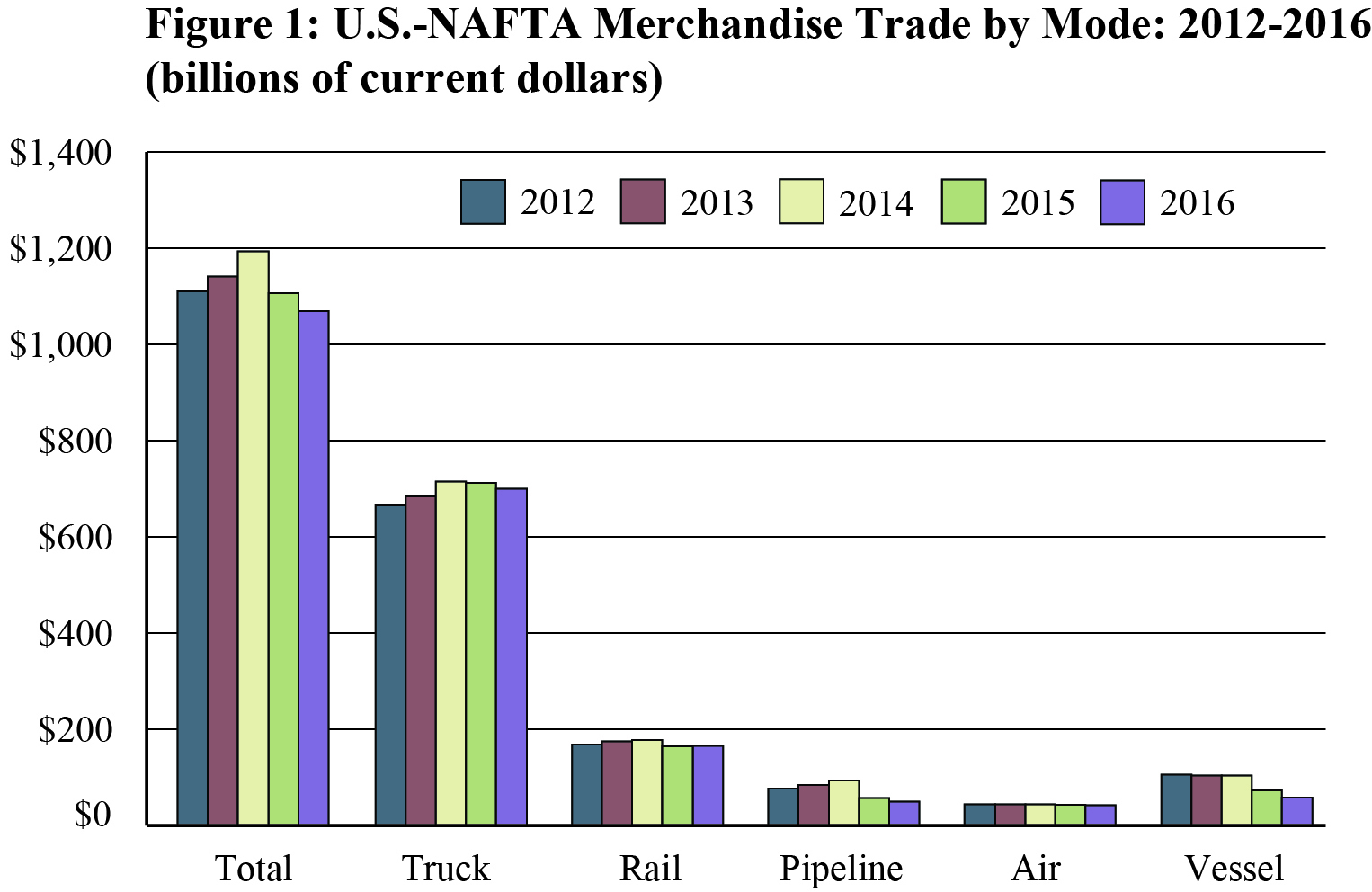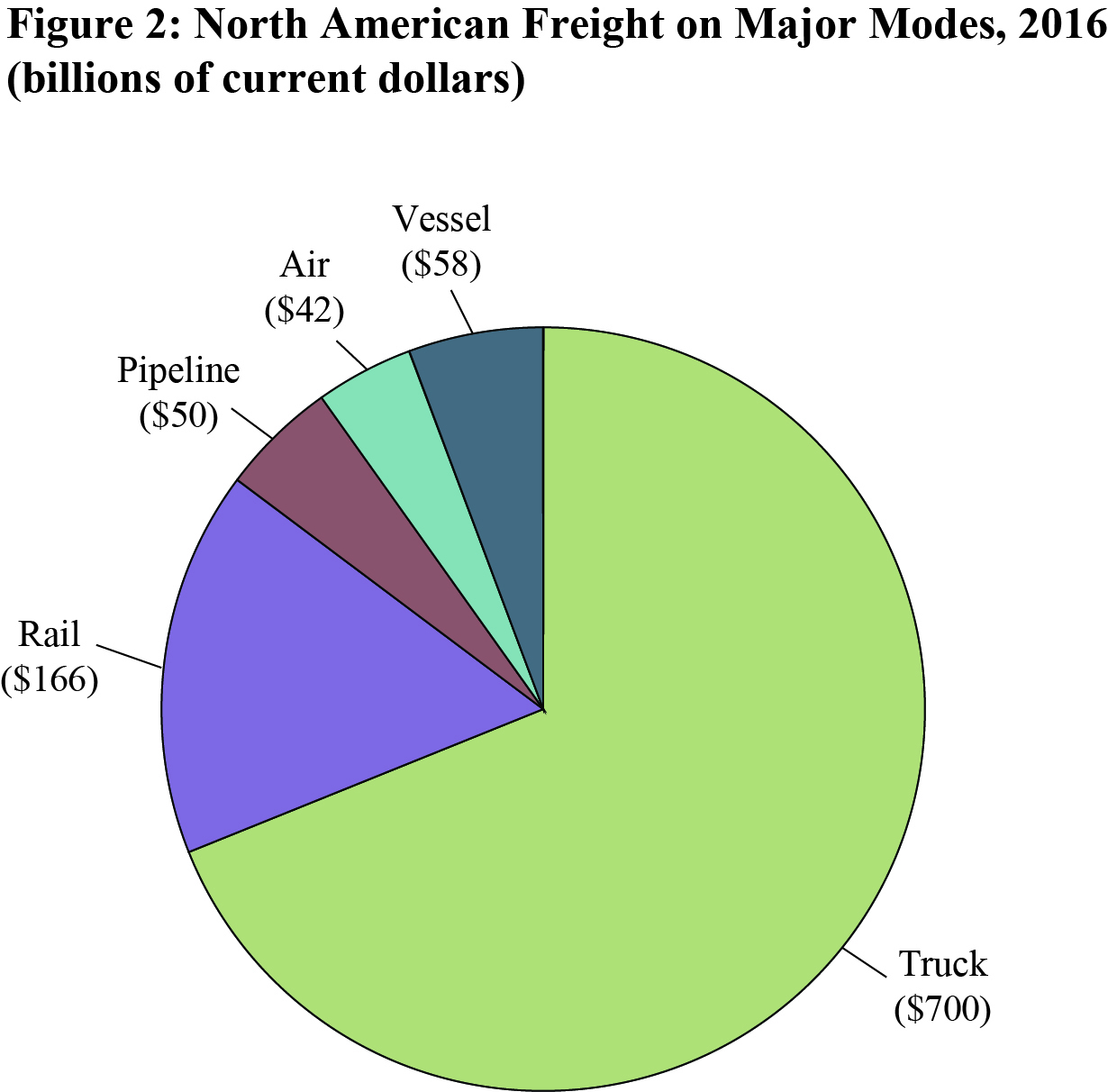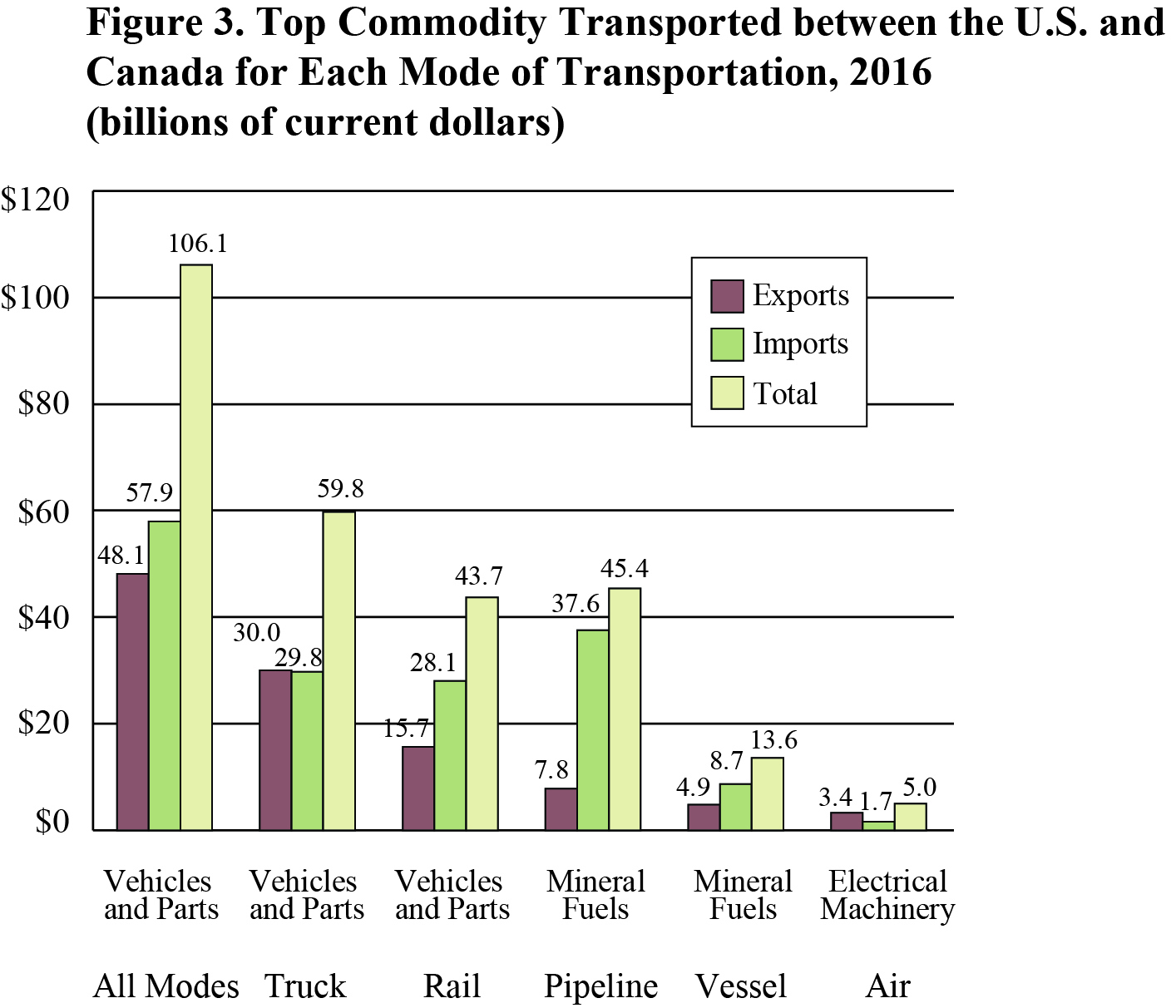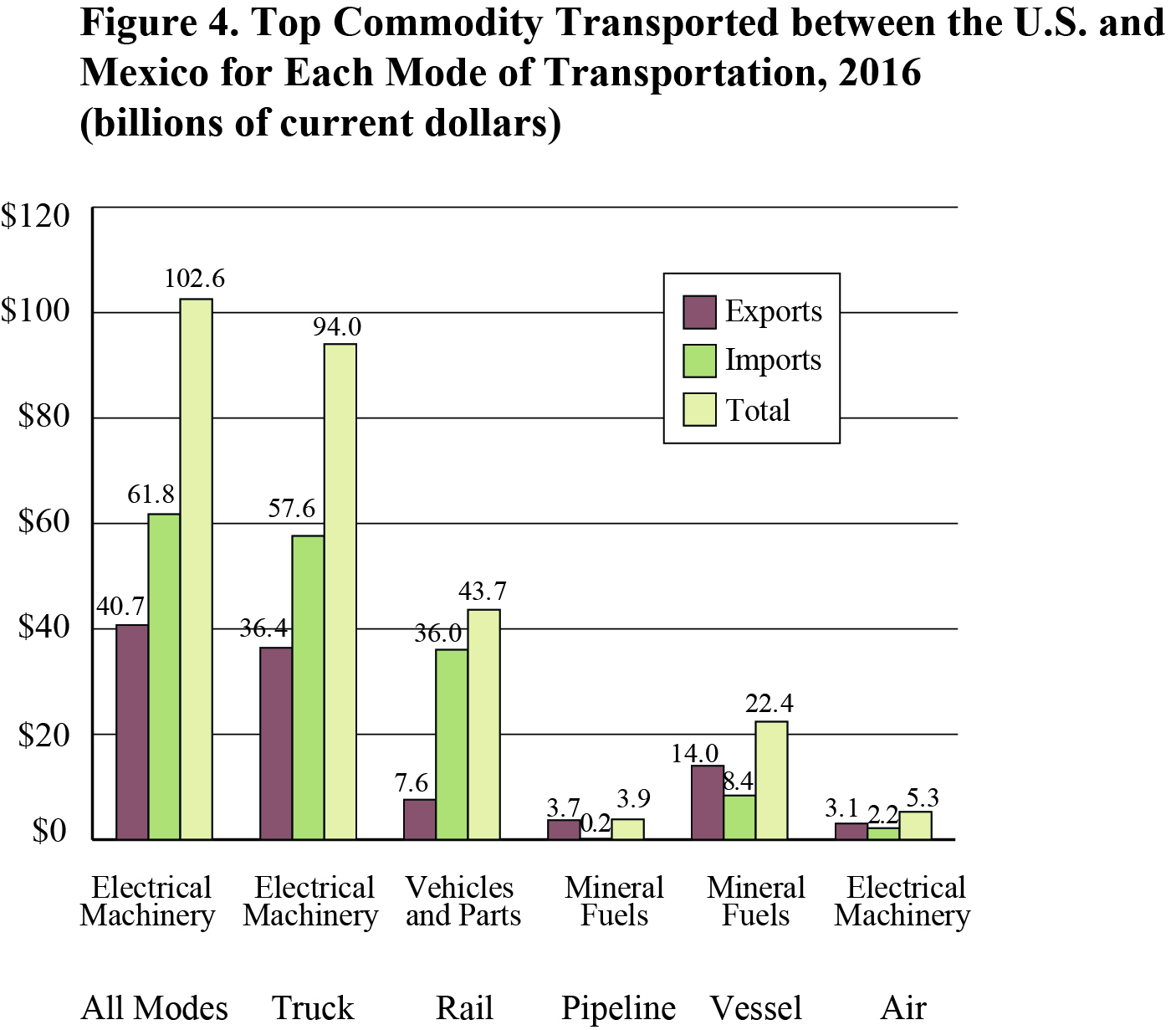BTS Statistical Release: 2016 North American Freight Numbers
U.S. Department of Transportation sent this bulletin at 03/02/2017 11:03 AM EST |
|
Having trouble viewing this email? View it as a Web page. |
BTS 11-17
Thursday, March 2, 2017
Contact: Dave Smallen
Tel: 202-366-5568
BTS Statistical Release: 2016 North American Freight Numbers

SOURCE: Bureau of Transportation Statistics, TransBorder Freight Data
Four out of five major transportation modes – truck, pipeline, vessel and air – carried less U.S. freight and with North American Free Trade Agreement (NAFTA) partners Canada and Mexico by value in 2016 than in 2015. Rail is the only major mode to carry more freight, increasing by 0.2 percent. The total value of cross-border freight carried on all modes fell 3.4 percent from 2015 to $1.069 trillion in current dollars, according to the U.S. Department of Transportation’s Bureau of Transportation Statistics (BTS) (Figure 1 and Table 1).
Freight by Mode
The modal share of commodities moving by truck increased by 1.1 percentage points, rail increased by 0.5 percentage points, and air was unchanged from 2015 to 2016. The modal share of freight on other modes declined: pipeline by 0.5 percentage points and vessel by 1.1 percentage points.
A large drop in the year-over-year price of crude oil in early 2016 played a key role in the annual declines in the dollar value of goods shipped by vessel (down 20.0 percent) and pipeline (down 12.9 percent). By the end of 2016, the year-over-year price of crude oil was increasing. Average monthly prices for crude petroleum and refined fuel are available from the U.S. Energy Information Administration.

SOURCE: Bureau of Transportation Statistics, TransBorder Freight Data
Trucks carried 65.5 percent of U.S.-NAFTA freight, a 1.1 percentage point increase from 2006, and continued to be the most heavily utilized mode for moving goods to and from both U.S.-NAFTA partners. Trucks accounted for $362.0 billion of the $572.2 billion of imports (63.3 percent) and for $338.0 billion of the $496.9 billion of exports (68.0 percent) (Table 1).
Rail remained the second largest mode, moving 15.5 percent of all U.S.-NAFTA freight, followed by vessel, 5.5 percent; pipeline, 4.6 percent and air, 3.9 percent. The surface transportation modes of truck, rail and pipeline carried 85.6 percent of the total value of U.S.-NAFTA freight flows (Figure 2, Table 1).
Trucks carried 63.3 percent of the $572.2 billion of imports, followed by rail, 18.8 percent; pipeline, 6.6 percent; vessel, 5.2 percent; and air, 3.1 percent. Truck carried 68.0 percent of the $496.9 billion of exports, followed by rail, 11.7 percent; vessel, 5.8 percent; air, 4.8 percent; and pipeline, 2.4 percent (Table 1).
The category of all modes of transportation cited in the following tables includes freight movements by truck, rail, vessel, pipeline, air, other and unknown modes of transport. See North American Transborder Freight Data for historical data.
Freight with Canada
From 2015 to 2016, the value of U.S.-Canada freight flows fell 5.4 percent to $544.0 billion. Trucks carried 60.1 percent of the value of the freight to and from Canada, followed with rail by 16.2 percent; pipeline by 8.4 percent, vessel by 3.3 percent; and air by 4.8 percent. The surface transportation modes of truck, rail and pipeline carried 84.8 percent of the value of total U.S.-Canada freight flows (Table 2).
Trucks carried 60.1 percent of U.S.-Canada freight in 2016, a 1.3 percentage point increase from 2006. Rail and air both had a percent share gain of 0.2 points, while vessel’s share fell 0.6 points and pipeline’s share fell 2.1 points (Table 2).
Trucks carried 53.5 percent of the $278.1 billion of 2016 imports from Canada, followed by rail, 21.1 percent; pipeline, 13.6 percent; vessel, 4.1 percent; and air, 4.0 percent. Truck carried 67.1 percent of the $266.0 billion of 2016 exports to Canada, followed by rail, 11.2 percent; air, 5.6 percent; pipeline, 3.0 percent; and vessel, 2.5 percent (Table 2).
Michigan led all states in freight with Canada in 2016 with $71.8 billion, and increase of 3.9 percent. The other top 10 states for U.S.-Canada freight in 2016 all showed year-over-year decreases, Indiana had the smallest percent decrease over 2015 by 0.3 percent. Texas had the largest percent decrease over 2015 among the top 10 states, by 15.0 percent (Table 3).
The top commodity category transported between the U.S. and Canada in 2016 was vehicles and parts at $106.1 billion with $59.8 billion or 56.4 percent moving by truck (Figure 3).
Freight with Mexico
From 2015 to 2016, the value of U.S.-Mexico freight fell 1.1 percent to $525.1 billion. Trucks carried 71.0 percent of the value of the freight to and from Mexico, followed with rail by 14.7 percent; vessel by 7.7 percent; air by 3.0 percent; and pipeline by 0.7 percent. The surface transportation modes of truck, rail and pipeline carried 86.4 percent of the value of total U.S.-Mexico freight flows (Table 4).
Trucks carried 71.0 percent of U.S.-Mexico freight in 2016, a 5.0 percentage point increase from 2006. Rail’s share increased by 1.7 percentage points from 2006, while pipeline’s share increased by 0.5 percentage points, air’s share declined by 0.5 percentage points and vessel’s percentage share fell 7.0 points (Table 4).
Trucks carried 72.5 percent of the $294.2 billion of 2016 imports from Mexico, followed by rail, 16.5 percent; vessel, 6.2 percent; air, 2.4 percent; and pipeline, 0.1 percent. Truck carried 69.1 percent of the $231.0 billion of 2016 exports to Mexico, followed by rail, 12.4 percent; vessel, 9.6 percent; air, 3.8 percent; and pipeline, 1.6 percent (Table 4).
Texas led all states in freight with Mexico in 2016 with $173.7 billion. Of the top 10 states for U.S.-Mexico freight in 2016, Michigan had the highest percent change over 2016, increasing by 11.0 percent (Table 5).
The top commodity transported between the U.S. and Mexico in 2016 was electrical machinery at $102.6 billion, with $94.0 billion or 91.6 percent moved by truck. The next highest commodity category transported by a single mode in U.S.-Mexico freight was vehicles and parts with $43.7 billion in freight moved by rail (Figure 4).
Reporting Notes
Statistical releases and the BTS website define surface transportation modes as truck, rail and pipeline. See North American TransBorder Freight Data on the BTS website for additional data for surface modes since 1995 and all modes since 2004. The category for all modes of transportation cited in the following tables includes freight movements by truck, rail, vessel, pipeline, air, other and unknown modes of transport.
Data in this press release are not adjusted for inflation. Additional summary data adjusted for inflation and exchange rates can be found on the BTS website under TransBorder Indexed Freight Flow Data. The BLS indexes used in the adjustments for inflation and exchange rates may be revised in each of the three months after original publication. For more information, see TransBorder Releases for previous releases and summary tables. BTS has scheduled the release of January TransBorder numbers for March 23.
Table 1. Modal Shares of U.S.-NAFTA Freight Flows
Freight by All Modes
(millions of current dollars)
|
Mode |
|
2006 |
2015 |
2016 |
Percent Change 2006-2016 |
Percent Change 2015-2016 |
|
All Modes |
Imports |
501,675 |
589,931 |
572,218 |
14.1 |
-3.0 |
|
Exports |
364,424 |
516,394 |
496,920 |
36.4 |
-3.8 |
|
|
Total |
866,099 |
1,106,325 |
1,069,138 |
23.4 |
-3.4 |
|
|
|
|
|||||
|
Share of Total by Mode (percent of total value) |
Percentage Point Change 2006-2016 |
Percentage Point Change 2015-2016 |
||||
|
All Surface Modes |
Imports |
83.6 |
87.3 |
88.7 |
5.1 |
1.3 |
|
Exports |
82.3 |
81.1 |
82.1 |
-0.2 |
1.0 |
|
|
Total |
83.1 |
84.4 |
85.6 |
2.5 |
1.2 |
|
|
|
|
|||||
|
Truck |
Imports |
55.1 |
61.0 |
63.3 |
8.2 |
2.3 |
|
Exports |
70.6 |
68.2 |
68.0 |
-2.6 |
-0.1 |
|
|
Total |
61.6 |
64.3 |
65.5 |
3.9 |
1.1 |
|
|
|
|
|||||
|
Rail |
Imports |
17.8 |
18.4 |
18.8 |
1.0 |
0.4 |
|
Exports |
10.9 |
11.0 |
11.7 |
0.8 |
0.7 |
|
|
Total |
14.9 |
14.9 |
15.5 |
0.6 |
0.5 |
|
|
|
|
|||||
|
Pipeline |
Imports |
10.7 |
8.0 |
6.6 |
-4.1 |
-1.3 |
|
Exports |
0.8 |
1.9 |
2.4 |
1.6 |
0.4 |
|
|
Total |
6.6 |
5.2 |
4.6 |
-1.9 |
-0.5 |
|
|
|
|
|||||
|
Vessel |
Imports |
11.0 |
6.4 |
5.2 |
-5.8 |
-1.2 |
|
Exports |
4.1 |
6.8 |
5.8 |
1.7 |
-1.0 |
|
|
Total |
8.1 |
6.6 |
5.5 |
-2.6 |
-1.1 |
|
|
|
|
|||||
|
Air |
Imports |
2.5 |
3.0 |
3.1 |
0.6 |
0.2 |
|
Exports |
6.4 |
5.0 |
4.8 |
-1.6 |
-0.2 |
|
|
Total |
4.1 |
3.9 |
3.9 |
-0.2 |
0.0 |
|
Source: Bureau of Transportation Statistics, TransBorder Freight Data as of February 2017.
NOTES: Numbers might not add to totals due to rounding. Percent changes based on numbers prior to rounding. The value of trade for all modes is not equal to the sum of truck, rail, pipeline, vessel and air modes, it also includes shipments made by mail, foreign trade zones, and other transportation.
* The percent of modal share for all surface modes equals the sum of the share of the truck, rail and pipeline modes.
Table 2. Modal Shares of U.S.-Canada Freight Flows
Freight by All Modes
(millions of current dollars)
|
Mode |
|
2006 |
2015 |
2016 |
Percent Change 2006-2016 |
Percent Change 2015-2016 |
|
All Modes |
Imports |
303,416 |
295,190 |
278,067 |
-8.4 |
-5.8 |
|
Exports |
230,257 |
280,017 |
265,961 |
15.5 |
-5.0 |
|
|
Total |
533,673 |
575,207 |
544,027 |
1.9 |
-5.4 |
|
|
|
|
|||||
|
Share of Total by Mode (percent of total value) |
Percentage Point Change 2006-2016 |
Percentage Point Change 2015-2016 |
||||
|
All Surface Modes |
Imports |
88.0 |
86.7 |
88.2 |
0.2 |
1.6 |
|
Exports |
82.1 |
79.7 |
81.2 |
-0.8 |
1.5 |
|
|
Total |
85.4 |
83.3 |
84.8 |
-0.6 |
1.5 |
|
|
|
|
|||||
|
Truck |
Imports |
49.4 |
49.7 |
53.5 |
4.1 |
3.8 |
|
Exports |
71.4 |
67.3 |
67.1 |
-4.3 |
-0.2 |
|
|
Total |
58.9 |
58.3 |
60.1 |
1.3 |
1.9 |
|
|
|
|
|||||
|
Rail |
Imports |
20.8 |
21.1 |
21.1 |
0.3 |
0.0 |
|
Exports |
9.8 |
10.1 |
11.2 |
1.4 |
1.1 |
|
|
Total |
16.1 |
15.7 |
16.2 |
0.2 |
0.5 |
|
|
|
|
|||||
|
Pipeline |
Imports |
17.8 |
15.8 |
13.6 |
-4.2 |
-2.3 |
|
Exports |
0.9 |
2.3 |
3.0 |
2.1 |
0.7 |
|
|
Total |
10.5 |
9.3 |
8.4 |
-2.1 |
-0.9 |
|
|
|
|
|||||
|
Vessel |
Imports |
5.3 |
5.1 |
4.1 |
-1.2 |
-1.0 |
|
Exports |
2.2 |
4.6 |
2.5 |
0.3 |
-2.1 |
|
|
Total |
4.0 |
4.9 |
3.3 |
-0.6 |
-1.6 |
|
|
|
|
|||||
|
Air |
Imports |
2.8 |
3.7 |
4.0 |
1.2 |
0.3 |
|
Exports |
6.9 |
5.7 |
5.6 |
-1.3 |
-0.1 |
|
|
Total |
4.6 |
4.7 |
4.8 |
0.2 |
0.1 |
|
Source: Bureau of Transportation Statistics, TransBorder Freight Data as of February 2017.
NOTES: Numbers might not add to totals due to rounding. Percent changes based on numbers prior to rounding. The value of trade for all modes is not equal to the sum of truck, rail, pipeline, vessel and air modes, it also includes shipments made by mail, foreign trade zones, and other transportation.
* The percent of modal share for all surface modes equals the sum of the share of the truck, rail and pipeline modes.
Table 3. Top 10 States Freight Flows with Canada by All Modes of Transportation
Ranked by 2016 Value
(millions of current dollars)
|
State |
2015 |
2016 |
Percent Change 2015 - 2016 |
||
|
Value |
Rank |
Value |
Rank |
||
|
Michigan |
69,059 |
1 |
71,754 |
1 |
3.9 |
|
California |
44,783 |
2 |
43,964 |
2 |
-1.8 |
|
Illinois |
47,166 |
4 |
41,180 |
3 |
-12.7 |
|
Texas |
41,311 |
3 |
35,101 |
4 |
-15.0 |
|
Ohio |
33,913 |
5 |
30,601 |
5 |
-9.8 |
|
New York |
30,413 |
6 |
30,262 |
6 |
-0.5 |
|
Pennsylvania |
22,302 |
8 |
19,942 |
7 |
-10.6 |
|
Washington |
21,548 |
7 |
19,791 |
8 |
-8.2 |
|
Indiana |
18,819 |
9 |
18,757 |
9 |
-0.3 |
|
Tennessee |
14,406 |
10 |
13,842 |
10 |
-3.9 |
Source: Bureau of Transportation Statistics, TransBorder Freight Data as of February 2017.
NOTE: Percent change based on numbers prior to rounding.
Table 4. Modal Shares of U.S.-Mexico Freight Flows
(millions of current dollars)
|
Mode |
|
2006 |
2015 |
2016 |
Percent Change 2006-2016 |
Percent Change 2015-2016 |
|
All Modes |
Imports |
198,259 |
294,741 |
294,151 |
48.4 |
-0.2 |
|
Exports |
134,167 |
236,377 |
230,959 |
72.1 |
-2.3 |
|
|
Total |
332,426 |
531,118 |
525,110 |
58.0 |
-1.1 |
|
|
|
|
|||||
|
Share of Total by Mode (percent of total value) |
Percentage Point Change 2006-2016 |
Percentage Point Change 2015-2016 |
||||
|
All Surface Modes |
Imports |
76.9 |
82.9 |
89.1 |
12.2 |
6.1 |
|
Exports |
82.7 |
81.3 |
83.1 |
0.4 |
1.8 |
|
|
Total |
79.2 |
82.2 |
86.4 |
7.2 |
4.2 |
|
|
|
|
|||||
|
Truck |
Imports |
63.8 |
67.9 |
72.5 |
8.7 |
4.6 |
|
Exports |
69.3 |
67.0 |
69.1 |
-0.2 |
2.1 |
|
|
Total |
66.0 |
67.5 |
71.0 |
5.0 |
3.5 |
|
|
|
|
|||||
|
Rail |
Imports |
13.0 |
15.0 |
16.5 |
3.5 |
1.5 |
|
Exports |
12.9 |
12.3 |
12.4 |
-0.5 |
0.1 |
|
|
Total |
13.0 |
13.8 |
14.7 |
1.7 |
0.9 |
|
|
|
|
|||||
|
Pipeline |
Imports |
0.0 |
0.1 |
0.1 |
0.0 |
0.0 |
|
Exports |
0.5 |
2.0 |
1.6 |
1.1 |
-0.4 |
|
|
Total |
0.2 |
0.9 |
0.7 |
0.5 |
-0.2 |
|
|
|
|
|||||
|
Vessel |
Imports |
19.6 |
7.7 |
6.2 |
-13.5 |
-1.5 |
|
Exports |
7.5 |
9.4 |
9.6 |
2.1 |
0.2 |
|
|
Total |
14.7 |
8.5 |
7.7 |
-7.0 |
-0.8 |
|
|
|
|
|||||
|
Air |
Imports |
2.1 |
2.2 |
2.4 |
0.3 |
0.1 |
|
Exports |
5.5 |
4.1 |
3.8 |
-1.7 |
-0.4 |
|
|
Total |
3.5 |
3.1 |
3.0 |
-0.5 |
-0.1 |
|
Source: Bureau of Transportation Statistics, TransBorder Freight Data as of February 2017.
NOTES: Numbers might not add to totals due to rounding. Percent changes based on numbers prior to rounding. The value of trade for all modes is not equal to the sum of truck, rail, pipeline, vessel and air modes, it also includes shipments made by mail, foreign trade zones, and other transportation.
* The percent of modal share for all surface modes equals the sum of the share of the truck, rail and pipeline modes.
Table 5. Top 10 States Freight Flows with Mexico by All Modes of Transportation
Ranked by 2016 Value
(millions of current dollars)
|
State |
2015 |
2016 |
Percent Change 2015 - 2016 |
||
|
Value |
Rank |
Value |
Rank |
||
|
Texas |
177,997 |
1 |
173,711 |
1 |
-2.4 |
|
California |
71,889 |
2 |
71,624 |
2 |
-0.4 |
|
Michigan |
55,009 |
3 |
61,087 |
3 |
11.0 |
|
Illinois |
22,195 |
4 |
21,214 |
4 |
-4.4 |
|
Arizona |
16,760 |
5 |
15,777 |
5 |
-5.9 |
|
Ohio |
14,683 |
6 |
14,416 |
6 |
-1.8 |
|
Tennessee |
11,995 |
7 |
11,788 |
7 |
-1.7 |
|
Georgia |
9,732 |
9 |
9,991 |
8 |
2.7 |
|
Indiana |
10,059 |
10 |
9,380 |
9 |
-6.8 |
|
Florida |
8,266 |
10 |
8,614 |
10 |
4.2 |
Source: Bureau of Transportation Statistics, TransBorder Freight Data as of February 2017.
NOTE: Percent change based on numbers prior to rounding.

Source: Bureau of Transportation Statistics, TransBorder Freight Data as of February 2017.
NOTES: Numbers might not add to totals due to rounding. Percent changes based on numbers prior to rounding. The value of trade for all modes is not equal to the sum of truck, rail, pipeline, vessel and air modes, it also includes shipments made by mail, foreign trade zones, and other transportation.

Source: Bureau of Transportation Statistics, TransBorder Freight Data as of February 2017.
NOTES: Numbers might not add to totals due to rounding. Percent changes based on numbers prior to rounding. The value of trade for all modes is not equal to the sum of truck, rail, pipeline, vessel and air modes, it also includes shipments made by mail, foreign trade zones, and other transportation.

